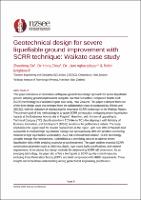| dc.description.abstract | This paper introduces an innovative earthquake geotechnical design approach for severe liquefiable ground, adopting ground improvement using the patented Subsurface Compacted Rubble Raft (SCRR) technology in a Waikato Region case study, New Zealand. This paper is derived from one of the three design cases that emerged from the collaborative research conducted by Wintec and GECNZ, with the objective of introducing the innovative SCRR technology to the Waikato Region. The primary goal of this methodology is to guide SCRR construction, mitigating severe liquefaction hazards at the Endeavour Avenue site in Flagstaff, Hamilton, with the aim of upgrading its Technical Category (TC) classification from TC3-like to TC1-like aligning it with Ministry of Business, Innovation, and Employment (MBIE) residential lot performance criteria. The study emphasizes the urgent need for disaster preparedness in the region, with over 20% of Waikato land susceptible to medium/high liquefaction damage and approximately 90% of Hamilton land facing medium to high liquefaction vulnerability. As a full land treatment solution, SCRR technology, versatile through five mechanisms, is identified as a promising solution to address severe liquefaction risks while avoiding excessive ground treatment. The paper outlines essential SCRR construction parameters such as thickness, depth, layer count, bulb specifications, and material requirements. It introduces four design methods for determining SCRR raft dimensions. As an emerging technology, the paper also offers a brief guide to SCRR quality control measures, including Cone Penetration Testing (CPT), and strict compliance with MBIE requirements. These insights aim to facilitate understanding among geotechnical engineering practitioners. | |

